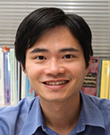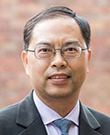
|
Professor Jeffrey Tai-kin Cheung
Professor
Department of Physics
Hong Kong Baptist University
Professor Jeffrey Tai-Kin Cheung graduated from Harvard University with a PhD degree in Chemistry. After working for two years in Oak Ridge National Laboratory, he joined Rockwell International Science Center and spent the next 31 years working on a diversity of challenging projects including synthesizing new materials by high power laser ablation, thin film devices, and harvesting power from random ocean waves. After retirement, he joined Hong Kong Baptist University as a visiting professor in the Department of Physics for 6 years and ventured into a new research area to study human motion both in static state and dynamic state with inertial measurement unit. In 2016, he founded Booguu Company to commercialize his inventions. His dream to invent something that is socially relevant is finally realized in the “A-I based Fall Risk Assessment System”. In his spare time, he pursues his hobby in origami as a way to relax and keep his mind busy at the same time.
Abstract
As demography is shifting toward an aging population, elderly fall has become a significant health care challenge. Traditional task-based fall risk assessment methods such as Timed Up and Go, Romberg’s Test and few others lack sufficient sensitivity and breadth to take all fall-causing factors into consideration and are effective only with those highly frail and at significant risk. However, the moderately at-risk elders that make up more than half of the elderly population in Hong Kong also need an accurate fall risk assessment to raise their early awareness and receive intervention to reduce risk. Advanced medical equipment such as Electronic Walkway and Balance monitoring apparatus are effective in this aspect. But their usefulness is limited due to their bulkiness, high cost, operational complexity and scarce availability. We have developed an award-winning portable fall risk assessment system to address this need. The core hardware is a triaxial inertial measurement unit (IMU) with accelerometer, gyro and magnetometer to capture motion with high position and temporal accuracy during a series of activities. The data will be analyzed on a cloud platform to extract information relevant to fall risk such as the sensor functionality, neuro-musculoskeletal interaction during static Postural Balance; the gait variability/symmetry during walking; and the lower limb strength during Sit to Stand test. Results are compared with golden standard to generate an A-I based Fall Risk Assessment score and report in less than five minutes. The time saving feature, low cost, high performance and versatility make this system an ideal tool to serve a large community or be used for personal health monitoring. |

|
Professor Raymond Kai-yu Tong
Professor
Department of Biomedical Engineering
The Chinese University of Hong Kong
Professor Raymond Kai-Yu Tong is a Biomedical Engineer and he is currently a Professor and Chairman in the Department of Biomedical Engineering, The Chinese University of Hong Kong. His research interests include Rehabilitation Robotics (e.g. Hand of Hope), Brain-Computer Control Interface (BCI), Neural Engineering, Functional Electrical Stimulation(FES) and Cognitive Assessment Software. He is recognized for his accomplishment in innovation and applied scientific research in neuro-rehabilitation for stroke patients and the elderly. Over the years, he has made great strides in developing a wide range of rehabilitation devices. His innovative work on rehabilitation robot system “Hand of Hope” was the first Hong Kong invention to have received the grand prize in the 40-year history of the International Exhibition of Inventions of Geneva. His research, innovation and service have received Awardee of the 2013 Hong Kong Ten Outstanding Young Persons; Winner Award (e-Health) in the Asia Pacific ICT Award 2012; and HKIE innovation awards for young members (2008), gold awards in international invention exhibitions (04’, 07’,10’,15’ &16’).
Abstract
Effective motor recovery after stroke depends on intensive voluntary practice of the paretic limbs. We developed interactive control strategies to control different rehabilitation training systems for hand and lower limb training in clinical trials using exoskeleton rehabilitation robot. The system incorporated the EMG and EEG as the bio-parameters to indicate the voluntary effort from a subject. We applied these engineering-based technologies in the field of Neurorehabilitation, robotic system uses electric motor to provide external assistive force during the rehabilitation training. Wearable designs had been developed to attach the exoskeleton system on hand and lower limb to generate functional movement for training. The clinical studies showed functional improvement in the clinical outcome measures on the upper limb and lower limb after the exoskeleton robotic training for 20-session on stroke survivors.
Another technology is AR System which is an intelligent platform with interaction, motivation for real-time monitoring of the body movements of the user during an exercise programme. It uses the state-of-the-art 3D body tracking technology to provide objective, accurate and comprehensive data on movement range, response, time and accuracy. Visual and audio feedback are provided to make the training more relaxing, interesting and convenient. Fifteen exercises (10 generic and 5 tailor-made exercises based on individual center’s requirements) are provided to cover a wide variety of options. Instant AR visual and audio feedback assist the subjects to complete the exercise tasks correctly, without the need of continuous assistance and monitoring by a clinical staff.
|
 |
Professor Yong-ping Zheng
Professor
Department of Biomedical Engineering
The Hong Kong Polytechnic University
Professor Yong-Ping Zheng has been serving as the Founding Head of the Department of Biomedical Engineering in The Hong Kong Polytechnic University (PolyU) during 2012-2020. He is currently the Director of the Jockey Club Smart Ageing Hub. He has been appointed as Henry G. Leong Professor in Biomedical Engineering since July 2017. Professor Zheng received the BEng and MEng in Electronics and Information Engineering from the University of Science and Technology of China. He received PhD degree in Biomedical Engineering from PolyU in 1997. After a Postdoctoral Fellowship at the University of Windsor, Canada, he joined PolyU as an Assistant Professor and was promoted to Professor in 2008, and Chair Professor in 2019. He served as the Associate Director of the Research Institute of Innovative Products in PolyU from 2008 to 2010. He also serves as the Director of Jockey Club Smart Ageing Hub since 2017. His main research interests include biomedical ultrasound, wearable sensors for healthcare, and smart aging technologies. He is a Senior Member of Institute of Electrical and Electronics Engineering (IEEE), a Fellow of Hong Kong Institution of Engineers (HKIE), Secretary of World Association of Chinese Biomedical Engineers (2017-2019). He has trained 12 PhD and 9 MPhil students, and over 10 postdoctoral fellows. He is currently supervising 9 PhD. He is also an inventor of more than 50 patents, published over 250 journal papers, and wrote a book “Measurement of Soft Tissue Elasticity In Vivo: Techniques and Applications”, several technologies invented by his team have been successfully commercialized, including Scolioscan (http://scolioscan.com), an ultrasound device to provide radiation-free assessment of scoliosis. He also served as Associate Editor and Editorial Board Members for many journals.
Abstract
Background
Hong Kong is facing big challenge of a rapidly ageing population. The estimated ratio between the working to elderly population will be 2:1 by 2035, while it is about 4:1 now, and 10:1 in 1980. With joint effort of researchers and developers, many innovative technologies are being developed for tackling this global phenomenon. To bridge the gap between research and practice use of gerontechnology devices, it is crucial to build a common platform to bridge different stakeholders for providing innovative while effective technological solutions for ageing.
Methods
With a generous support of HKD48M (US$6.2M) from The Hong Kong Jockey Club Charities Trust , The Hong Kong Polytechnic University launched the project entitled “Jockey Club Smart Ageing Hub (JCSAH, http://www.polyu.edu.hk/ageing)”, in Dec 2017. JCSAH provides an interdisciplinary platform for researchers, industrialists, caregivers, non-government organizations, professionals, ageing service providers, elderly, students, policy makers, etc. to interact with each other to develop and adopt innovative and quality technology products that best fit for the elderly. Through showcasing cutting-edge gerontechnology and assistive products from around the world, the project aims to raise public awareness about the benefits of applying innovative technology in supporting ageing in place and continuum of care.
Results
JCSAH has attracted great interests of various stakeholders, A “Day Experience Centre” was established within The Hong Kong Polytechnic University campus (the “Centre”) in Oct 2018. The Centre contains 4 key areas: a thematic zone for raising public awareness on common elderly health issues, an interactive experience zone for trial of advanced technology, a smart home show flat installed with various innovation technologies and a resource library for display and trial of categorized gerontech items. Through showcasing gerontechnology products, conducting demonstrations, exhibitions, workshops and experiential activities, the Centre aims to demonstrate the application of ageing-in-place technology to the public. Besides, JCSAH collaborates with 4 non-governmental organizations to set up “Real-life Hostels” as examples of adoption of gerontech in elderly nursing hostels. Appropriate gerontechnology devices, such as eNightLog, Smart Interactive Dolls etc. were installed in hostels for the staff to support elderly, thereby relieving the work pressure of frontline staff. Industrial visits were arranged in 2019, to let cross-boundary stakeholders see in-person the implementation of the gerontech and to encourage the industry to make good use of technology for providing quality elderly services.
Discussion
Since 2017, the JCSAH project has built a cross-region & cross-sector network with worldwide working partners. The project drew thousands of visitors from far and wide to visit the Day Experience Centre and Real-life Hostels, joined gerontech-related exhibitions, workshops, seminars and symposiums that were organized by the JCSAH. Thus, the potential for bridging of such an interdisciplinary hub has already been demonstrated. JCSAH is eager to collaborate with more stakeholders working on gerontechnology. |